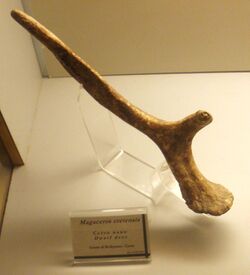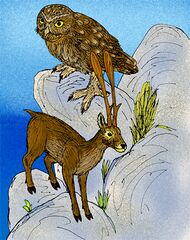Biology:Candiacervus
| Candiacervus Temporal range: late Middle - Late Pleistocene
| |
|---|---|

| |
| Candiacervus cretensis antler | |
| Scientific classification | |
| Domain: | Eukaryota |
| Kingdom: | Animalia |
| Phylum: | Chordata |
| Class: | Mammalia |
| Order: | Artiodactyla |
| Family: | Cervidae |
| Genus: | †Candiacervus Kuss, 1975 |
| Species | |
| |
Candiacervus is an extinct genus of deer native to Pleistocene Crete.[1] Due to a lack of other herbivores, the genus underwent an adaptive radiation, filling niches occupied by other taxa on the mainland. Due to the small size of Crete, some species underwent insular dwarfism,[2] the smallest species, C. ropalophorus, stood about 40 cm at the shoulders when fully grown, as can be inferred from a mounted skeleton,[3] while other species were relatively large and comparable in size to mainland deer species. Some species (C. ropalophorus) are noted for their peculiar, elongate club-shaped antlers, though other species have more normal antlers.
Taxonomy
The Cretan deer is a typical example of taxonomical problems involving endemic insular mammals, due to the much larger variety than on the mainland, and the strong endemism. This obscures taxonomy, because many endemic features of Candiacervus are not unique but are found in other island deer as well,[4] such as Cervus astylodon (Ryukyu Islands) and Hoplitomeryx (Southern Italy). De Vos (1979, 1984, 1996)[5][6][7] identified eight morphotypes into one genus (Candiacervus), whereas Capasso Barbato (1992)[8] included the larger species, rethymnensis, major and dorothensis, in Cervus (subgenus Leptocervus) and the smaller species ropalophorus and cretensis in Megaloceros (subgenus Candiacervus), implying two different ancestors, and she also did not recognize sp. II with its three morphotypes, instead referring it to ropalophorus. A new paper published in 2018 rejected the conclusion of Capasso Barbato (1992) and formally named the three morphotypes of De Vos' Candiacervus sp. II C. devosi, C. listeri, and C. reumeri.[9]
On the nearby island of Karpathos, Kuss[10] found deer which were, in his view, similar to the Cretan deer. Therefore, he grouped his species pygadiensis and cerigensis under the genus Candiacervus, but this needs further confirmation. As long as no direct link with Crete is attested, the deer genus of Karpathos is questioned, and better referred to as Cervus.
They were traditionally considered to be related to the giant Irish elk, with some experts regarding Candiacervus as a subgenus of Megaloceros.[8] However, van der Geer (2018) finds them closer to Dama.[9]
Description
The Cretan deer is represented by no less than eight different morphotypes, ranging from dwarf size with withers height of about 40 cm to very large with withers height of about 165 cm,[6] spanning a body mass range from 27.8 kg in the smallest species C. ropalophorus to 245.4 kg in the largest species C. major. This is explained as an adaptive radiation following ecological release to occupy available niches. The larger species had proportionally longer legs than mainland deer, while the dwarf species had proportionally shorter legs.[11] The large size of the only known individual of C. major may be due to pituitary gigantism, in which case the species may be a synonym of one of the smaller species, perhaps the red deer sized C. dorothensis.[12] The short legs of the dwarf species is suggested to be an adaptation to a goat-like niche of climbing around on rocky terrain and consuming low quality foliage.[13] The antler morphology was highly varied, in some of the dwarf species like C. ropalophorus, the antler was simplified and greatly elongated into a club like structure unique amongst all deer, while others retained a more typical antler morphology. The club-like antlers of C. ropalophorus were probably only used for display rather than combat.[9] The antler and skull morphology is unknown in the largest species.[11]
Ecology
The fauna of which Candiacervus is an element is called Biozone II, or the Mus Zone (after the Mus genus of mice).[14] This fauna inhabited Crete between the late Middle and Late Pleistocene, which means between 0.3 and 0.01 million years ago. It succeeds the Kritimys biozone, which spanned the Early-early Middle Pleistocene.[15]
The typical terrestrial mammalian fauna elements of this biozone aside from Candiacervus are a lineage of mice (Mus bateae, M. minotaurus), a dwarf elephant (Palaeoloxodon creutzburgi), the Cretan otter (Lutrogale (Isolalutra) cretensis), and the Cretan shrew (Crocidura zimmermanni).[16]
Despite living in an environment free of large terrestrial predators, the species of Candiacervus exhibited relatively high rates of juvenile mortality, with likely causes of death being accidents and malnutrition.[17] Adult individuals are suggested to have had relatively long lifespans compared to extant ruminants.[17][18]
Extinction
The extinction of Candiacervus may be due to the arrival of humans at the end of the Pleistocene.[19] They could have exterminated the deer either actively by hunting, or passively by destroying its habitat. Another option is a gradual depletion of the ecosystem, as indicated by the finding of a complete herd consisting of individuals suffering a bone disease of an osteosclerotic nature (see X-ray photograph).[20] The impact of paleolithic humans is at present still unproven, partly because of the scarcity on published fauna lists from archaeological sites (except for Knossos), partly because of the insecurely dated materials.
In 2018 it was proposed that petrogylphs in Asphendou Cave in western Crete depicted Candiacervus, suggesting that humans and Candiacervus chronologically overlapped on the island.[21]
References
- ↑ Van der Geer, A.A.E., Dermitzakis, M., De Vos, J. 2006. Crete before the Cretans: the reign of dwarfs. Pharos 13, 121-132. Athens: Netherlands Institute.PDF
- ↑ Van der Geer, A.A.E., De Vos, J., Dermitzakis, M., Lyras, G., 2009. Hoe dieren op eilanden evolueren. Majorca, Ibiza, Kreta, Sardiniie, Sicilie, Japan, Madagaskar, Malta. Utrecht: Veen Magazines; ISBN:978-90-8571-169-8.Ga naar Bruna
- ↑ Van der Geer, A.A.E., De Vos, J., Lyras, G., Dermitzakis, M. 2005. The mounting of a skeleton of the fossil species Candiacervus sp. II from Liko Cave, Crete, Greece. Monografies de la Societat d'Història Natural de les Balears 12, 337-346
- ↑ Van der Geer, A.A.E. 2005. Island ruminants and the evolution of parallel functional structures. In: Cregut, E. (Ed.): Les ongulés holarctiques du Pliocène et du Pléistocène. Actes Colloque international Avignon, 19-22 septembre. Quaternair, 2005 hors-série 2: 231-240. Paris. PDF
- ↑ De Vos, J. 1979. The endemic Pleistocene deer of Crete. Proceedings of the Koninklijke Nederlandse Akademie van Wetenschappen, Series B 82 (1), 59-90
- ↑ 6.0 6.1 De Vos J. 1984. The endemic Pleistocene deer of Crete. Verhandelingen der Koninklijke Nederlandse Akademie van Wetenschappen, afd. Natuur¬kunde, eerste reeks 31. North Holland Publishing Compa¬ny. Amsterdam, Oxford, New York. 100 pp.
- ↑ De Vos, J. 1996. Taxonomy, Ancestry and Speciation of the Endemic Pleistocene Deer of Crete Compared with the Taxonomy, Ancestry and Speciation of Darwin's Finches. In: Reese, 1996, 111-24.
- ↑ 8.0 8.1 Capasso Barbato L. 1992b. Observations on the biostratigraphy of Cretan Pleistocene vertebrates. Il Quaternario 5 (1), 67-76.
- ↑ 9.0 9.1 9.2 van der Geer, Alexandra (2018). "Uniformity in variety: Antler morphology and evolution in a predator-free environment". Palaeontologia Electronica 21 (1): 1–31. doi:10.26879/834. http://palaeo-electronica.org/content/2018/2159-uniformity-in-variety.
- ↑ Kuss S.E., 1975. Die pleistozänen Hirsche der ostmediterranen Inseln Kreta, Kasos, Karpatos und Rhodos (Griechenland). Berichte der Naturforschenden Gesellschaft zu Freiburg im Breisgau, 65 (1 2), 25-79.
- ↑ 11.0 11.1 Besiou, Eva; Choupa, Maria; Lyras, George; van der Geer, Alexandra (2022). "Body mass divergence in sympatric deer species of Pleistocene Crete (Greece)". Palaeontologia Electronica. doi:10.26879/1221. https://palaeo-electronica.org/content/2022/3663-body-mass-of-candiacervus.
- ↑ Palombo, Maria Rita; Zedda, Marco (January 2022). "The intriguing giant deer from the Bate cave (Crete): could paleohistological evidence question its taxonomy and nomenclature?" (in en). Integrative Zoology 17 (1): 54–77. doi:10.1111/1749-4877.12533. ISSN 1749-4877. PMID 33728744. PMC 9292671. https://onlinelibrary.wiley.com/doi/10.1111/1749-4877.12533.
- ↑ Van der Geer, A.A.E., De Vos, J., Lyras, G., Dermitzakis, M. (2006). New data on the Pleistocene Cretan deer Candiacervus sp. II (Mammalia, Cervinae). In: Kahlke, R.-D., Maul, L. C. & Mazza, P. (Eds.): Late Neogene and Quaternary biodiversity and evolution: Regional developments and interregional correlations. Proceedings of the 18th International Senckenberg Conference (VI International Palaeontological Colloquium in Weimar) vol. II. Courier Forschungsinstitut Senckenberg 256, 131-137. Frankfurt am Main.
- ↑ Mayhew, D.F. 1977. The endemic Pleistocene murids of Crete I-II. Proceedings of the Koninklijke Nederlandse Akademie van Wetenschappen B, 80 (3), 182-214.
- ↑ Dermitzakis, M.D. & J. De Vos 1987. Faunal Succession and the Evolution of Mammals in Crete during the Pleistocene. Neues Jahrbuch Geologischer und Paläontologischer Abhandlungen 173 (3), 377-408.
- ↑ Lyras, George A.; Athanassiou, Athanassios; van der Geer, Alexandra A. E. (2022), Vlachos, Evangelos, ed., "The Fossil Record of Insular Endemic Mammals from Greece" (in en), Fossil Vertebrates of Greece Vol. 2 (Cham: Springer International Publishing): pp. 661–701, doi:10.1007/978-3-030-68442-6_25, ISBN 978-3-030-68441-9, https://link.springer.com/10.1007/978-3-030-68442-6_25, retrieved 2023-04-30
- ↑ 17.0 17.1 van der Geer, Alexandra A. E.; Lyras, George A.; MacPhee, Ross D. E.; Lomolino, Mark; Drinia, Hara (2014-06-24). "Mortality in a Predator-free Insular Environment: the Dwarf Deer of Crete" (in en). American Museum Novitates 3807 (3807): 1–26. doi:10.1206/3807.1. ISSN 0003-0082. http://www.bioone.org/doi/abs/10.1206/3807.1.
- ↑ Miszkiewicz, Justyna J; Van Der Geer, Alexandra A E (2022-04-22). "Inferring longevity from advanced rib remodelling in insular dwarf deer" (in en). Biological Journal of the Linnean Society 136 (1): 41–58. doi:10.1093/biolinnean/blac018. ISSN 0024-4066. https://academic.oup.com/biolinnean/article/136/1/41/6554026.
- ↑ Sondaar, P.Y., Van der Geer, A.A.E. 2005. Evolution and Extinction of Plio-Pleistocene Island Ungulates. In: Cregut, E. (Ed.): Les ongulés holarctiques du Pliocène et du Pléistocène. Actes Colloque international Avignon, 19-22 septembre. Quaternair, 2005 hors-série 2: 241-256. Paris.
- ↑ Dermitzakis M., Van der Geer AAE, Lyras G. 2006. Palaeopathological observations on a population of fossil deer from the Late Pleistocene of Crete. In: Kalofourtis, A., Papadopoulos, N., Spiliopoulou, C., Marabellas, K., Chatzioannou, A.. Volume in Honor of Prof. A.S. Koutselinis, pp. 43–51. [in Greek with English summary] PDF
- ↑ Strasser, Thomas F.; Murray, Sarah C.; van der Geer, Alexandra; Kolb, Christina; Ruprecht, Louis A. (April 2018). "Palaeolithic cave art from Crete, Greece" (in en). Journal of Archaeological Science: Reports 18: 100–108. doi:10.1016/j.jasrep.2017.12.041. https://linkinghub.elsevier.com/retrieve/pii/S2352409X17306259.
External links
- Article on the mounting of a Candiacervus skeleton[yes|permanent dead link|dead link}}]
- Scientific information on Candiacervus
- Past excavations on Crete
Wikidata ☰ Q3655192 entry



